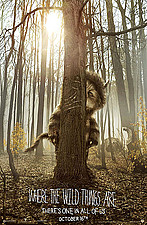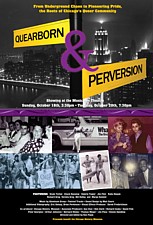
Knight at the Movies Archives
A hidden part of Chicago history revealed, a beloved children's classic gets an imaginative though mournful expansion
It’s taken out filmmaker Ron Pajak over ten years to assemble the final cut of Quearborn & Perversion, his anecdotal overview
of Chicago’s gay history. But the tinkering has paid off and Pajak, who makes his feature debut with this compelling labor of love
has assembled a deeply emotional, captivating portrait of our local queer forebears. Pajak’s documentary will have its world premiere
on Sunday, Oct. 18 at 3:30pm and Tuesday, Oct. 20 at 7:30pm at the Music Box Theatre (3733 N. Southport). Like last year’s
WTTW documentary “Out & Proud,” I think it should be required viewing for not just those interested in Chicago’s queer history, but
Chicago’s history period.
Chicago’s blue collar, macho image was at odds with the first attempts at gay lib – to say the least – back in 1924 when Henry
Gerber started the city’s first gay rights group. But ironically, Illinois was also the only state in the country where homosexual activity
wasn’t illegal. Pajak, utilizing archival footage, photographs, memorabilia, and computer graphics, takes us on an overview of some
of the city’s gay firsts. Our tour guides are a host of vibrant gay and lesbian pioneers and their kin – activists, authors, artists,
performers, just plain folks – who share their bitter, sweet and often hilarious reminisces without hesitation.
Several of the city’s social gay history hallmarks are affectionately remembered – Chicago’s first drag club (back in the 30’s), the
first rough trade bar Benny the Bum’s (1947), Big Lou’s, the first lesbian bar (from the early 50’s – before that lesbians often met at
ballgames), the popular drag bar the Chesterfield from the mid-60’s. Often, it’s the private parties held behind closed doors –
accompanied by amazing home movie footage – that elicit the most vivid memories. Then Pajak moves into darker territory and a
catalogue of human rights indignities and shameful incidents suffered by Our People are recounted which resulted – slowly – in the
rise of gay activism with the Mattachine Society and other activist groups coming together.
Pajak also includes an overview of the black gay and lesbian community and the film doesn’t pull any punches when noting the
“segregation within the segregation” that occurred within the gay community. Quearborn & Perversion ends as Chicago queer history
entered a new era – on June 28, 1970 – the date of Chicago’s first pride parade which kicked off from Bug House Square (the once
infamous gay hustler cruising park at Dearborn and Division whose nickname is the film’s title).
The less than 150 participants then bravely marched down Michigan Avenue (at one point in the amazing archival footage they’re
ironically seen walking past a theatre showing the gay camp infused Myra Breckenridge) and into the loop toward Daley Plaza
demanding gay rights – setting us up perfectly for a sequel. Here’s hoping Pajak finds the funding and a shorter time frame to bring
it about. Music by the Aluminum Group.
Pajak will appear in person at both screenings which will partially benefit the Chicago History Museum. www.musicboxtheatre.com
+++++++++++++++++++++++++++++++++++++++++++++++++++++++++++++++++++++++++++++++++++++++++++++
Spike Jonze, the clever director of Being John Malkovich, Adaptation and a host of music videos, brings forth his most personal film, a
long overdue screen version of Where the Wild Things Are. Based on the children’s classic from out writer Maurice Sendak, in
addition to directing Jonze has co-written the film adaptation of the ten sentence book with novelist Dave Eggers. The film moves
away from the simple child’s fantasy of the book and repositions it as a winning though rather melancholy variation on the classic
boy and a dog story. Only this time, it’s a boy and his monster.
Max (played by Max Records who has the somber quality inherent in the best child actors) is given a divorced mother (Catherine
Keener), distracted from paying attention to him by a new romance (Mark Ruffalo in a cameo), and an older sister who is more into
her new friends than her pesky little brother. Alone and lonely, he acts out his frustrations and anger with a batch of bad behavior
that shocks mom and sends the hysterical Max fleeing out into the night.
Boarding a boat, he sails away, eventually landing on the unnamed island where the Wild Things await. They’re like big moving
shag carpets – you can almost touch their fur and smell them (Jonze really makes them come alive). Lead by the angry Carol
(voiced by James Gandolfini), the Wild Things proclaim Max their new king though Judith (voiced by Catherine O’Hara) mournfully
asks, “Can you stop the sadness from getting in?” which hints at a shared group anxiety. The other Wild Things are voiced by Chris
Cooper, Paul Dano, Forest Whittaker, Lauren Ambrose, and Michael Berry, Jr. each of whom are given a distinct personality by these
marvelous actors. They’re a fractious bunch – always picking fights and worrying even in the midst of playing there’s trouble.
Max develops a special rapport with Carol, who takes him on a tour of his new kingdom. Max eagerly takes to his new role and soon
the Wild Things are building a new shelter out of rocks and twigs and throwing dirtballs at each other. No one talks much (the
movie's a kindred spirit to The Black Stallion) but slowly it dawns on the group that Max isn’t really a king with special powers and
eventually Max yearns to return to his own home.
Jonze really gets the feeling of another world. The production and costumes are beautifully realized – you can almost see the snot
in the noses of the monsters who resemble snorting bulls. It’s a tactile, textured movie – very dense and immediate – far, far away
from the fantasies of Oz or Hogwarts or other childhood, faraway places and the exhilaration in Where the Wild Things Are is always
short lived. A patina of melancholy overrides the entire movie (helped along by the raft of wistful tunes on the soundtrack). It’s a
straight forward kid’s picture that looks at the problems and anxieties of being a child in the way that the Charlie Brown cartoons
did. It’s not always so great being a kid, Jonze is reminding us and the boy and his monster allegory – as in E.T. (boy and his
alien), Old Yeller (boy and his dog), etc. – overlaid on the original story is particularly apt to the current cultural zeitgeist. It plays
right into this closed in, anxious world of ours – makes the material contemporary.
Is there anything anyone can do to keep a child in that innocent world anymore? Jonze seems to ask and the answer as presented
here is a forlorn and definite “No.” The world is too present – too intrusive – and it’s just too hard to keep kids away from that –
safe and unaware of the larger concerns of the world. Jonze gets all this in subtly – as well as the power that lies in utilizing a large
imagination and in the closeness with the mother and the stubborn individuality, there’s more than a hint of gay subtext, too.
The movie’s not really for kids but rather, for their grownup kid parents, moonstruck dreamers and especially for those who like to
wallow emotionally. Where the Wild Things Are is like the movie incarnation of every sad café poetry slam. When it’s over you just
want to sit there and sigh for awhile – then go home and have a cup of tomato soup and a grilled cheese and be tucked into bed
and cry yourself to sleep – as long as mom is nearby.
of Chicago’s gay history. But the tinkering has paid off and Pajak, who makes his feature debut with this compelling labor of love
has assembled a deeply emotional, captivating portrait of our local queer forebears. Pajak’s documentary will have its world premiere
on Sunday, Oct. 18 at 3:30pm and Tuesday, Oct. 20 at 7:30pm at the Music Box Theatre (3733 N. Southport). Like last year’s
WTTW documentary “Out & Proud,” I think it should be required viewing for not just those interested in Chicago’s queer history, but
Chicago’s history period.
Chicago’s blue collar, macho image was at odds with the first attempts at gay lib – to say the least – back in 1924 when Henry
Gerber started the city’s first gay rights group. But ironically, Illinois was also the only state in the country where homosexual activity
wasn’t illegal. Pajak, utilizing archival footage, photographs, memorabilia, and computer graphics, takes us on an overview of some
of the city’s gay firsts. Our tour guides are a host of vibrant gay and lesbian pioneers and their kin – activists, authors, artists,
performers, just plain folks – who share their bitter, sweet and often hilarious reminisces without hesitation.
Several of the city’s social gay history hallmarks are affectionately remembered – Chicago’s first drag club (back in the 30’s), the
first rough trade bar Benny the Bum’s (1947), Big Lou’s, the first lesbian bar (from the early 50’s – before that lesbians often met at
ballgames), the popular drag bar the Chesterfield from the mid-60’s. Often, it’s the private parties held behind closed doors –
accompanied by amazing home movie footage – that elicit the most vivid memories. Then Pajak moves into darker territory and a
catalogue of human rights indignities and shameful incidents suffered by Our People are recounted which resulted – slowly – in the
rise of gay activism with the Mattachine Society and other activist groups coming together.
Pajak also includes an overview of the black gay and lesbian community and the film doesn’t pull any punches when noting the
“segregation within the segregation” that occurred within the gay community. Quearborn & Perversion ends as Chicago queer history
entered a new era – on June 28, 1970 – the date of Chicago’s first pride parade which kicked off from Bug House Square (the once
infamous gay hustler cruising park at Dearborn and Division whose nickname is the film’s title).
The less than 150 participants then bravely marched down Michigan Avenue (at one point in the amazing archival footage they’re
ironically seen walking past a theatre showing the gay camp infused Myra Breckenridge) and into the loop toward Daley Plaza
demanding gay rights – setting us up perfectly for a sequel. Here’s hoping Pajak finds the funding and a shorter time frame to bring
it about. Music by the Aluminum Group.
Pajak will appear in person at both screenings which will partially benefit the Chicago History Museum. www.musicboxtheatre.com
+++++++++++++++++++++++++++++++++++++++++++++++++++++++++++++++++++++++++++++++++++++++++++++
Spike Jonze, the clever director of Being John Malkovich, Adaptation and a host of music videos, brings forth his most personal film, a
long overdue screen version of Where the Wild Things Are. Based on the children’s classic from out writer Maurice Sendak, in
addition to directing Jonze has co-written the film adaptation of the ten sentence book with novelist Dave Eggers. The film moves
away from the simple child’s fantasy of the book and repositions it as a winning though rather melancholy variation on the classic
boy and a dog story. Only this time, it’s a boy and his monster.
Max (played by Max Records who has the somber quality inherent in the best child actors) is given a divorced mother (Catherine
Keener), distracted from paying attention to him by a new romance (Mark Ruffalo in a cameo), and an older sister who is more into
her new friends than her pesky little brother. Alone and lonely, he acts out his frustrations and anger with a batch of bad behavior
that shocks mom and sends the hysterical Max fleeing out into the night.
Boarding a boat, he sails away, eventually landing on the unnamed island where the Wild Things await. They’re like big moving
shag carpets – you can almost touch their fur and smell them (Jonze really makes them come alive). Lead by the angry Carol
(voiced by James Gandolfini), the Wild Things proclaim Max their new king though Judith (voiced by Catherine O’Hara) mournfully
asks, “Can you stop the sadness from getting in?” which hints at a shared group anxiety. The other Wild Things are voiced by Chris
Cooper, Paul Dano, Forest Whittaker, Lauren Ambrose, and Michael Berry, Jr. each of whom are given a distinct personality by these
marvelous actors. They’re a fractious bunch – always picking fights and worrying even in the midst of playing there’s trouble.
Max develops a special rapport with Carol, who takes him on a tour of his new kingdom. Max eagerly takes to his new role and soon
the Wild Things are building a new shelter out of rocks and twigs and throwing dirtballs at each other. No one talks much (the
movie's a kindred spirit to The Black Stallion) but slowly it dawns on the group that Max isn’t really a king with special powers and
eventually Max yearns to return to his own home.
Jonze really gets the feeling of another world. The production and costumes are beautifully realized – you can almost see the snot
in the noses of the monsters who resemble snorting bulls. It’s a tactile, textured movie – very dense and immediate – far, far away
from the fantasies of Oz or Hogwarts or other childhood, faraway places and the exhilaration in Where the Wild Things Are is always
short lived. A patina of melancholy overrides the entire movie (helped along by the raft of wistful tunes on the soundtrack). It’s a
straight forward kid’s picture that looks at the problems and anxieties of being a child in the way that the Charlie Brown cartoons
did. It’s not always so great being a kid, Jonze is reminding us and the boy and his monster allegory – as in E.T. (boy and his
alien), Old Yeller (boy and his dog), etc. – overlaid on the original story is particularly apt to the current cultural zeitgeist. It plays
right into this closed in, anxious world of ours – makes the material contemporary.
Is there anything anyone can do to keep a child in that innocent world anymore? Jonze seems to ask and the answer as presented
here is a forlorn and definite “No.” The world is too present – too intrusive – and it’s just too hard to keep kids away from that –
safe and unaware of the larger concerns of the world. Jonze gets all this in subtly – as well as the power that lies in utilizing a large
imagination and in the closeness with the mother and the stubborn individuality, there’s more than a hint of gay subtext, too.
The movie’s not really for kids but rather, for their grownup kid parents, moonstruck dreamers and especially for those who like to
wallow emotionally. Where the Wild Things Are is like the movie incarnation of every sad café poetry slam. When it’s over you just
want to sit there and sigh for awhile – then go home and have a cup of tomato soup and a grilled cheese and be tucked into bed
and cry yourself to sleep – as long as mom is nearby.
Explorations:
Quearborn & Perversion-Where the Wild Things Are
Expanded Edition of 10-14-09 Windy City Times KATM Column*
By Richard Knight, Jr.
Quearborn & Perversion-Where the Wild Things Are
Expanded Edition of 10-14-09 Windy City Times KATM Column*
By Richard Knight, Jr.
CHECK OUT OTHER KATM FILM REVIEWS IN THE ARCHIVES


*Where the Wild Things screened after my WCT deadline but in time for me to include my review here
